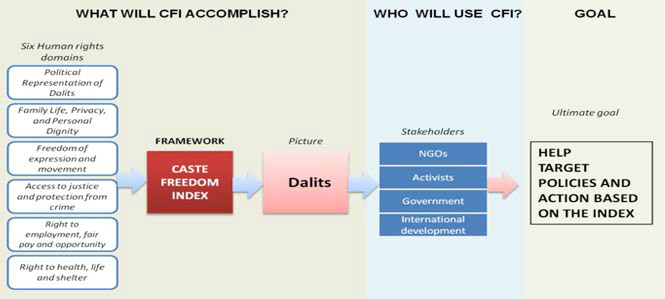



Research & Reports
Caste Freedom Index
The International Commission for Dalit Rights (ICDR) introduced the need for and value of developing Caste Freedom Index (CFI) as a unique and universal framework addressing inequalities and measuring caste discrimination, untouchability, and socio-political exclusion of nearly five million the world’s most marginalized, vulnerable, and socio-politically excluded population known as “OutCastes” or “Oppressed people”. OutCastes have been victimized, discriminated against, and excluded from mainstream development progress based on their caste or work and descent in many parts of South Asia, and many parts of the world.

Caste Freedom Index provides ample information and advocacy frameworks:
Caste Freedom Index (CFI) is a unique and universal framework addressing inequalities and measure discrimination based on caste or descent of nearly 260 million the world’s most marginalized and socially excluded population known as “OutCastes” or “Oppressed people”, who have been victimized, discriminated against and excluded from mainstream development progress based on their caste or work and descent in South Asia, parts of Africa, the Middle East and other part of the world.
CFI FUNCTIONALITY: Responding to Discrimination
At present, there is no single instrument to measure and monitor caste-based discrimination and untouchability, or caste and gender-based violence at the national and global level. ICDR believes that creating a standardized measurement and advocacy framework will provide a clear and present benchmark for determining the current status of discrimination and, importantly, will enable progress towards a positive social impact. The CFI would be testimonial information that helps US Congress to pass a binding resolution against Caste-based discrimination that expands the geographic scope of its historical HR 139 on Untouchability in India (House Concurrent Resolution 139). It will also provide information to advance the UN’s Draft Principles and Guidelines for the Effective Elimination of Discrimination based on Work and Descent (UN Human Rights Council, A/HRC/11/CRP.3).
THE CFI INSTRUMENT
The CFI instrument will be a comprehensive statistical measure of the degree to which Dalit people are allowed freedom and inclusiveness in their society. The project objectives are: 1) to develop the methodological basis for the CFI to promote individual rights and freedom, and political representation through a CFI pilot study in Nepal. The outcome of the CFI is to be an instrument achieving ten-year strategy program to eliminate caste-based discrimination and untouchability developed by the Dalit NGO Federation (DNF) with the technical assistance of the ICDR and funding support of Enabling State Program (ESP)/Department for International Development.
6 Dimensions of CFI
In the theoretical design of CFI, a comprehensive approach to measurement, that can lead to actions improving the situation of OutCastes in a given country, is included a two-dimensional matrix of human rights juxtaposed with socio-political domains. Included in this framework are the six dimensions of human rights:
1. The right to life, health and shelter- Physical assaults on individuals
- Denial of access to water supplies
- Unlawful destruction of homes
- Prevention of inter-caste marriage or persecution of inter-caste couples
- Institutionalised prostitution
- Unlawful eviction from homes
- Denial of entry to certain occupations
- Prevention of equal access to education
- Unfair pay or conditions compared to others
- Denial of entry to places of worship
- Restriction to limited areas of residence
- Denial of rights to hold or stand for public office
- Prevention from voting
- Improper failure to prosecute offenders against OutCastes or their property
- Refusal by officials to enforce legal protections
- Socio-political domains for the CFI
Constitutional and Legal Principles
How well do the national constitution, laws, and rulings of superior courts, affirm and protect the rights of OutCastes in respect of each dimension of human rights?
Political and social actionHow well do government policies, the statements and actions of politicians and other influential figures, and the conduct of political life and civil society organisations, treat OutCastes positively and/or equally in respect each dimension of human rights?
Economic activityHow far the policies and practices of economic actors such as do banks, employers and customers, give OutCastes equal rights and opportunities with respect to each dimension of human rights?
Community relationsHow far do prevailing social structures and the relationships between OutCastes and others, at the community (social group and/or locality) level, uphold the rights and dignity of OutCastes with respect to each dimension of human rights?
Individual and family experienceHow much does the everyday experience of OutCastes reflect the desired aim of equality and the absence of discrimination or persecution, with respect to each dimension of human rights?

